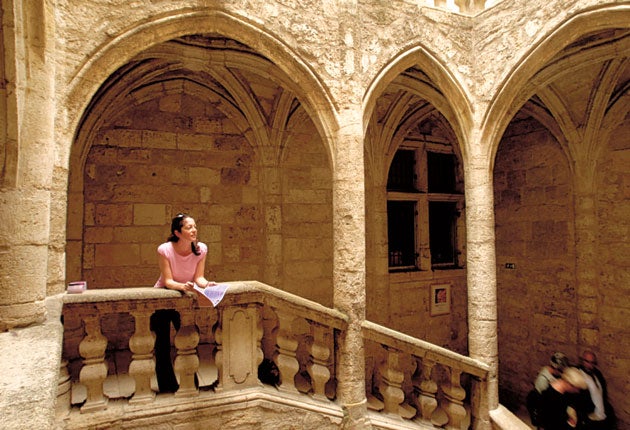Pézenas: a stroll through the past
Promenade beside eclectic historical architecture, says Emily Reynolds

Your support helps us to tell the story
From reproductive rights to climate change to Big Tech, The Independent is on the ground when the story is developing. Whether it's investigating the financials of Elon Musk's pro-Trump PAC or producing our latest documentary, 'The A Word', which shines a light on the American women fighting for reproductive rights, we know how important it is to parse out the facts from the messaging.
At such a critical moment in US history, we need reporters on the ground. Your donation allows us to keep sending journalists to speak to both sides of the story.
The Independent is trusted by Americans across the entire political spectrum. And unlike many other quality news outlets, we choose not to lock Americans out of our reporting and analysis with paywalls. We believe quality journalism should be available to everyone, paid for by those who can afford it.
Your support makes all the difference.The antique town of Pézenas is one of the quiet glories of southern France. What you see at the outset is a glorious place of elegant 17th- and 18th-century houses constructed in mellow, honey-coloured stone and graced with balconies and twirling wrought-iron.
These gracious buildings exude a refined atmosphere and have an edge of grandeur entirely in keeping with Pézenas’s past as the capital of Languedoc. The town lost its political power in the late 17th century but it continued to thrive as a market centre and it continued to expand over the ensuing century.
Stroll the broad thoroughfare of cours Jean Jaures and you’ll take in some of the most striking of the townhouses. Then look again. The northern side of the road was built on the old town walls that had been constructed to protect an ancient, densely packed warren of medieval houses.
And behind the handsome houses, the old town of Pézenas remains. At the north-west end of cours Jean Jaures, walk through the gateway adjacent to place Ledru Rollin and you step into a palpably different world. It is a car-defying maze of alleys lined with dwellings that have over the years been added to and augmented so that you see a 14th-century arch here, an 18th-century window there, a 17th-century façade complete with carvings fronting a building a good 200 years older. Adding to the intrigue is the absorbing history of this atmospheric tangle of an old town.
Immediately to the left of that opening archway is another arch with a sign above it announcing that thiswas the medieval Jewish quarter. It is a small space of just one short road with some of its buildings still adorned with Jewish emblems – yet it is quite remarkable, particularly given that the Jewish community in France was expelled in 1394 on the order of King Charles VI.
They are thought to have lived amicably here. And they were, apparently, unconcerned by the presence of the Knights Templar, who had fortified quarters nearby. The templar order was, of course, a huge challenge to the French royalty and, under pressure of King Philip IV of France, was disbanded by the Pope in 1312, the property passing to the Knights of St John. Today the church of St-Jean, largely built in the 18th century, occupies some of the site of the original complex constructed by the Knights Templar in the 12th century.
Fast forward to the 17th century, the hey-day of the town as an important centre. The great and the good flocked here. And they required entertaining. So it was that in 1646 Jean-Baptiste Poquelin, better known by his stage name of Molière, first arrived in Languedoc. Over the course of the next 12 years he and his troupe of actors toured the region extensively, with Pézenas a frequent base.
You can find out about Molière’s life and times at the tourist office, which stages a lively 3D film about the actor-playwright.
The building alone is well worth visiting in its own right. Hotel Peyrat is a complex property that in the course of time has housed the town prison as well as offering more elegant accommodation to aristocrats. The old jail section now contains a small, free exhibition on crafts in Pézenas while the upper floors house another free display, this one devoted to the town’s eclectic architecture.
But for all the well preserved history here, there is no sense of time standing still. Plenty of new projects are in the offing. A Jewish museum is currently being mooted and will probably be housed in a building by the old Jewish quarter. A luxury apartment hotel is under construction in a former distillery. The 46 suites of the Garrigae Pézenas are due to open next summer.
Pézenas has a tradition of fine craftsmanship and this year a new initiative of craft displays will be taking place. It starts with workshops and displays at the craft centre in the old town at place Gambetta on 2 April – which has been designated as national craft day in France. And it will continue in July and August when craft shows will be staged daily (except Sundays), with demonstrations of metal working, stone carving and wood turning.
For more information contact the tourist office.
Travel essentials
What to do
Scenovision Molière (00 33 4 67 98 35 39; scenovisionmoliere.com). The 3D film show in French and English is presented on the upper floors of the tourist office (see below for details) daily 9am-noon and 2-6pm (from 10am on Sun), with extended hours over the peak summer season; adults €7.
More information
Pézenas Tourist Office, Hotel Peyrat, Place des Etats du Languedoc (00 33 4 67 98 36 40; pezenas-tourisme.fr)
Join our commenting forum
Join thought-provoking conversations, follow other Independent readers and see their replies
Comments